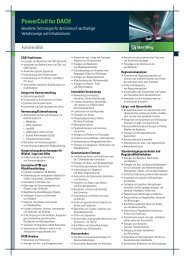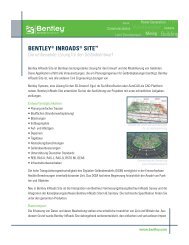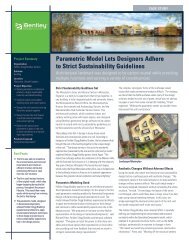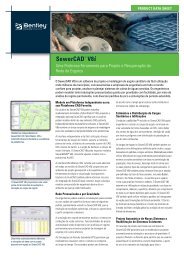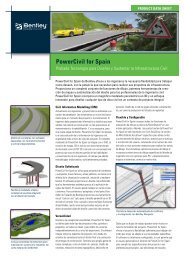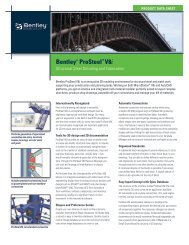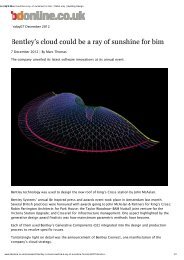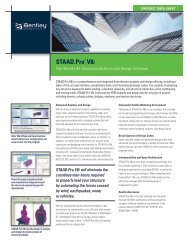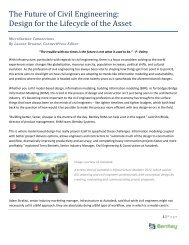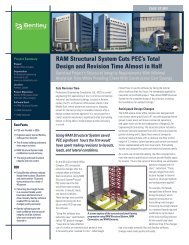Best Practices in Front-End Design - FTP - Bentley
Best Practices in Front-End Design - FTP - Bentley
Best Practices in Front-End Design - FTP - Bentley
Create successful ePaper yourself
Turn your PDF publications into a flip-book with our unique Google optimized e-Paper software.
<strong>Best</strong> <strong>Practices</strong><br />
<strong>in</strong> <strong>Front</strong>-<strong>End</strong><br />
<strong>Design</strong><br />
A <strong>Bentley</strong> White Paper<br />
Arv<strong>in</strong>d Patel<br />
Bus<strong>in</strong>ess Development Manager<br />
Conceptual <strong>Design</strong> and FEED Applications<br />
www.bentley.com
Eng<strong>in</strong>eers are <strong>in</strong>creas<strong>in</strong>gly<br />
pressured to make sound<br />
<strong>in</strong>vestment decisions<br />
earlier <strong>in</strong> a project, even<br />
as the pool of available<br />
eng<strong>in</strong>eer<strong>in</strong>g resources to<br />
tackle those decisions<br />
cont<strong>in</strong>ues to shr<strong>in</strong>k.<br />
<strong>Best</strong> <strong>Practices</strong> <strong>in</strong> <strong>Front</strong>-<strong>End</strong> <strong>Design</strong><br />
INTRODUCTION<br />
Every year, owner-operators <strong>in</strong> the hydrocarbon and related process <strong>in</strong>dustries <strong>in</strong>vest<br />
several billion dollars construct<strong>in</strong>g new plants, revamp<strong>in</strong>g exist<strong>in</strong>g ones, improv<strong>in</strong>g<br />
safety and environmental compliance, and <strong>in</strong>creas<strong>in</strong>g system reliability. They <strong>in</strong>vest<br />
even more <strong>in</strong> asset management and ma<strong>in</strong>tenance programs.<br />
All of these projects must be cost-effectively delivered on ever-tighter schedules by<br />
firms and their project teams deal<strong>in</strong>g with an <strong>in</strong>creas<strong>in</strong>g shortfall <strong>in</strong> the number of<br />
highly skilled eng<strong>in</strong>eers available to tackle these challenges. It’s clear that the shortage<br />
affects each project phase from concept, through front-end and detailed design, to<br />
construction, operations, and ma<strong>in</strong>tenance. This shortage <strong>in</strong> eng<strong>in</strong>eer<strong>in</strong>g talent also<br />
impacts every supply cha<strong>in</strong> l<strong>in</strong>k, <strong>in</strong>clud<strong>in</strong>g plant equipment suppliers, which report<br />
<strong>in</strong>creas<strong>in</strong>g lead-times even for such once commonly available items as valves and pumps.<br />
The ability to secure, <strong>in</strong> a timely fashion, materials and labor to deliver projects or carry<br />
out ma<strong>in</strong>tenance is critical to bus<strong>in</strong>ess success, and requires effective <strong>in</strong>formation<br />
shar<strong>in</strong>g among the muti-discipl<strong>in</strong>ary firms typically <strong>in</strong>volved <strong>in</strong> these efforts.<br />
Unfortunately, today, this often isn’t the case. Because <strong>in</strong>formation generated by one<br />
discipl<strong>in</strong>e at a particular phase of a project’s lifecycle is not always shared or reused<br />
at another phase, bus<strong>in</strong>esses suffer from <strong>in</strong>efficient use of capital, poor returns on<br />
<strong>in</strong>vestment (ROI), and <strong>in</strong>creased project risks due to <strong>in</strong>consistencies <strong>in</strong> project deliverables<br />
that take time and cost money to resolve.<br />
Fig. 1. Typical workflow <strong>in</strong> front-end design projects<br />
Eng<strong>in</strong>eers are <strong>in</strong>creas<strong>in</strong>gly pressured to make sound <strong>in</strong>vestment decisions earlier <strong>in</strong> a<br />
project, even as the pool of available eng<strong>in</strong>eer<strong>in</strong>g resources to tackle those decisions<br />
cont<strong>in</strong>ues to shr<strong>in</strong>k. However, process <strong>in</strong>dustries can improve project performance by<br />
2
<strong>Best</strong> <strong>Practices</strong> <strong>in</strong> <strong>Front</strong>-<strong>End</strong> <strong>Design</strong><br />
adopt<strong>in</strong>g a multi-discipl<strong>in</strong>ary, concurrent workflow that ensures all eng<strong>in</strong>eer<strong>in</strong>g decisions<br />
made dur<strong>in</strong>g the conceptual design and front-end eng<strong>in</strong>eer<strong>in</strong>g phases of a project are<br />
based on sound asset lifecycle knowledge and best design practices. Ever more design<br />
decisions, such as material selections and plant layout that are typically made at the<br />
detailed design phase, are now made at the front-end eng<strong>in</strong>eer<strong>in</strong>g and design (FEED)<br />
phase (Fig. 1). In fact, detailed P&IDs and 3D plant models at the FEED stage are developed<br />
much earlier so that <strong>in</strong>formed decisions based on cost implications can be made. This<br />
also ensures that major ma<strong>in</strong>tenance or constructability issues don’t arise dur<strong>in</strong>g the<br />
eng<strong>in</strong>eer<strong>in</strong>g/procurement/construction (EPC) phase.<br />
In the follow<strong>in</strong>g, we will discuss some of the major challenges project teams face<br />
while work<strong>in</strong>g on front-end eng<strong>in</strong>eer<strong>in</strong>g and design projects.We will also describe the<br />
approach <strong>Bentley</strong> Systems has taken to address some workflow challenges dur<strong>in</strong>g<br />
conceptual design and FEED. For example, <strong>Bentley</strong> offers AXSYS ® .Process and<br />
PlantWise ® for fast and effective solutions to screen alternative process designs and<br />
plant layouts, and to help project teams arrive at an optimum concept for the project.<br />
<strong>Bentley</strong> also offers a comprehensive range of FEED applications that can be <strong>in</strong>itiated<br />
from data <strong>in</strong> AXSYS.Process and PlantWise. These applications <strong>in</strong>clude pip<strong>in</strong>g and<br />
<strong>in</strong>strumentation diagrams (P&IDs), <strong>in</strong>strumentation and wir<strong>in</strong>g schematics, electrical<br />
schematics, datasheets for <strong>in</strong>itial vendor <strong>in</strong>quiry, tools for collaborative design reviews,<br />
methods for assess<strong>in</strong>g failure result<strong>in</strong>g from corrosion, and <strong>in</strong>itiat<strong>in</strong>g 3D plant design.<br />
Moreover, because <strong>Bentley</strong> uses the <strong>in</strong>dustry standard ISO 15926 data exchange model<br />
to deliver <strong>in</strong>teroperability, users can select the best-<strong>in</strong>-class applications for their<br />
front-end design projects.<br />
Key Challenges <strong>in</strong> Plann<strong>in</strong>g Capital Projects<br />
Screen<strong>in</strong>g Process Alternatives<br />
Screen<strong>in</strong>g process alternatives, generally performed by senior process eng<strong>in</strong>eers,<br />
<strong>in</strong>volve the use of several stand-alone software tools <strong>in</strong>clud<strong>in</strong>g process simulation<br />
programs, heat exchanger design tools, equipment siz<strong>in</strong>g methods, and various CAD<br />
tools to draft process flow diagrams (PFDs). Here, the challenge becomes the effective<br />
management of workflows and track<strong>in</strong>g of design changes dur<strong>in</strong>g this fast-track<br />
activity. This calls for a central process database capable of deal<strong>in</strong>g with both graphics<br />
and design data, and the ability to <strong>in</strong>terface with <strong>in</strong>formation from external process<br />
simulators and siz<strong>in</strong>g programs, thereby provid<strong>in</strong>g a managed concurrent eng<strong>in</strong>eer<strong>in</strong>g<br />
environment for screen<strong>in</strong>g process alternatives.<br />
Convey<strong>in</strong>g the <strong>Design</strong> Intent<br />
By effectively convey<strong>in</strong>g the design <strong>in</strong>tent to plant owner-operators, delays <strong>in</strong> approval<br />
for the project can be avoided. Most people f<strong>in</strong>d it convenient to visualize the design<br />
<strong>in</strong>tent <strong>in</strong> 3D. So the question becomes: How is it possible to develop a 3D representation<br />
of the proposed facility us<strong>in</strong>g only prelim<strong>in</strong>ary process scope? A further question is:<br />
How can we effectively deal with demands for lower<strong>in</strong>g the total <strong>in</strong>stalled cost <strong>in</strong> a<br />
timely manner?<br />
3
Most conceptual<br />
design projects <strong>in</strong>volve<br />
concurrent eng<strong>in</strong>eer<strong>in</strong>g<br />
workflows, with all design<br />
discipl<strong>in</strong>es work<strong>in</strong>g<br />
simultaneously from a<br />
common database.<br />
<strong>Best</strong> <strong>Practices</strong> <strong>in</strong> <strong>Front</strong>-<strong>End</strong> <strong>Design</strong><br />
Early Scope of Bulk Materials<br />
Every cost eng<strong>in</strong>eer should receive an early def<strong>in</strong>ition of bulk materials from the design<br />
team <strong>in</strong> order to project a reliable cost estimate for the capital <strong>in</strong>vestment. The challenge,<br />
once aga<strong>in</strong>, is to def<strong>in</strong>e the scope of bulk materials without a detailed 3D plant design<br />
model. However, a conceptual 3D plant design model actually can be generated <strong>in</strong><br />
m<strong>in</strong>utes us<strong>in</strong>g a fast auto-rout<strong>in</strong>g application for pip<strong>in</strong>g.<br />
Integrated P&ID Development<br />
When it comes to <strong>in</strong>tegrated P&ID development, the challenge <strong>in</strong>volves not only develop<strong>in</strong>g<br />
P&IDs, but also ma<strong>in</strong>ta<strong>in</strong><strong>in</strong>g data consistency with process <strong>in</strong>formation, l<strong>in</strong>e siz<strong>in</strong>g<br />
data, and <strong>in</strong>strumentation and equipment def<strong>in</strong>itions — all while provid<strong>in</strong>g a flexible<br />
workflow across different geographic locations. This requires a data-centric workflow for<br />
develop<strong>in</strong>g P&IDs with complete control of revision and design changes, facilitat<strong>in</strong>g<br />
reviews and <strong>in</strong>corporat<strong>in</strong>g comments.<br />
Jump-Start<strong>in</strong>g Detail <strong>Design</strong><br />
Jump-start<strong>in</strong>g detail design has become more the norm for FEED projects. Because<br />
owner-operators demand shorter project schedules (Fig. 2), most of them are not<br />
prepared to delay the start of the eng<strong>in</strong>eer<strong>in</strong>g/procurement/construction (EPC) phase.<br />
Clearly, owner-operators would rather jump-start the detail design phase by reus<strong>in</strong>g<br />
FEED data.<br />
Fig. 2. Site Layout and Construction Must Start Early <strong>in</strong> the <strong>Design</strong><br />
<strong>Bentley</strong>’s Approach for Conceptual <strong>Design</strong><br />
Most conceptual design projects <strong>in</strong>volve concurrent eng<strong>in</strong>eer<strong>in</strong>g workflows, with all<br />
design discipl<strong>in</strong>es work<strong>in</strong>g simultaneously from a common database. Only a data-centric<br />
approach guarantees data consistency between schematics and design deliverables<br />
and allows:<br />
• Process eng<strong>in</strong>eers to manage multiple process simulation case studies and rapidly<br />
establish the govern<strong>in</strong>g case,<br />
• Equipment designers to reuse this data to design or rate critical heat transfer equipment,<br />
4
By comb<strong>in</strong><strong>in</strong>g users’<br />
best design practices <strong>in</strong><br />
the form of templates,<br />
the result<strong>in</strong>g PFDs and<br />
P&IDs are automatically<br />
generated with m<strong>in</strong>imum<br />
user <strong>in</strong>tervention.<br />
<strong>Best</strong> <strong>Practices</strong> <strong>in</strong> <strong>Front</strong>-<strong>End</strong> <strong>Design</strong><br />
• Mechanical eng<strong>in</strong>eers to develop their equipment specifications <strong>in</strong> the form of data<br />
sheets us<strong>in</strong>g Excel worksheets,<br />
• Layout designers to try multiple alternatives <strong>in</strong> response to process changes,<br />
• Cost eng<strong>in</strong>eers to extract the early bulk materials scope for their conceptual cost<br />
estimates — all from a common set of process data.<br />
This is the approach <strong>Bentley</strong> takes to address concurrent eng<strong>in</strong>eer<strong>in</strong>g workflows <strong>in</strong><br />
conceptual design, where rapid screen<strong>in</strong>g of alternative concepts is critical, and<br />
review<strong>in</strong>g the impact of changes <strong>in</strong> the proposed concept must be visualized quickly to<br />
ga<strong>in</strong> approval of the design <strong>in</strong>tent.<br />
Fig. 3. <strong>Bentley</strong>’s concurrent eng<strong>in</strong>eer<strong>in</strong>g approach<br />
<strong>Bentley</strong> AXSYS.Process for Conceptual Process <strong>Design</strong><br />
<strong>Bentley</strong> AXSYS.Process allows <strong>in</strong>creased evaluation of conceptual design cases and<br />
leverages corporate knowledge to significantly reduce capital expenditure for new plants<br />
and plant upgrades. It is a data-centric, database-driven application that provides<br />
rule-based methods for automat<strong>in</strong>g the selection of equipment items and draw<strong>in</strong>g<br />
creation directly from process simulation results (Fig. 4). By comb<strong>in</strong><strong>in</strong>g users’ best design<br />
practices <strong>in</strong> the form of templates, the result<strong>in</strong>g PFDs and P&IDs are automatically<br />
generated with m<strong>in</strong>imum user <strong>in</strong>tervention.<br />
The product supports <strong>in</strong>terfaces to most <strong>in</strong>dustry-standard process simulators, <strong>in</strong>clud<strong>in</strong>g<br />
HYSYS, Aspen Plus, Pro/II, and UniSim <strong>Design</strong>, along with such heat exchanger design<br />
programs as HTFS and HTRI. In addition, <strong>in</strong>terfaces to Excel-based datasheets and<br />
reports are supported as standard tools. Moreover, prelim<strong>in</strong>ary P&IDs generated<br />
5
<strong>Best</strong> <strong>Practices</strong> <strong>in</strong> <strong>Front</strong>-<strong>End</strong> <strong>Design</strong><br />
from AXSYS.Process can be further detailed us<strong>in</strong>g <strong>Bentley</strong>’s P&ID tools, <strong>in</strong>clud<strong>in</strong>g<br />
AutoPLANT ® P&ID, PlantSpace ® P&ID, and OpenPlant PowerPID. In addition, all affected<br />
design discipl<strong>in</strong>es can share the process data, while Lifecycle Server supports <strong>in</strong>tegration<br />
with an asset lifecycle data warehouse and ProjectWise ® supports workflows and<br />
document management.<br />
Fig. 4. <strong>Bentley</strong> AXSYS.Process - for process design<br />
Benefits of <strong>Bentley</strong> AXSYS.Process<br />
In order to realize the full benefits of AXSYS.Process, one must consider the “how-to’s,”<br />
such as how to generate process design deliverables, and “what-ifs,” <strong>in</strong>clud<strong>in</strong>g:<br />
• What if a different process technology is used?<br />
• What if the parts are not readily available from the manufacturer?<br />
• What if a different material selection is made for prolonged asset lifecycle?<br />
AXSYS.Process provides plant owner-operators with a unique opportunity to:<br />
• Compress time for process screen<strong>in</strong>g by up to 40 percent: Users have experienced<br />
great results with workflows <strong>in</strong> which a key factor is the screen<strong>in</strong>g of process<br />
alternatives. Simply by us<strong>in</strong>g the multicase feature <strong>in</strong> AXSYS.Process, eng<strong>in</strong>eers<br />
can select the desired simulation case and rapidly derive a design or govern<strong>in</strong>g case<br />
for the process design. Subsequent deliverables, such as process flow diagrams<br />
and heat and mass balance tables, are fully automated <strong>in</strong> AXSYS.Process, thereby<br />
achiev<strong>in</strong>g this level of schedule compression.<br />
• Elim<strong>in</strong>ate the need to re-enter data: Eng<strong>in</strong>eers can spend up to 30 percent of<br />
their time look<strong>in</strong>g for the most current data. With a data-centric approach to data<br />
and graphics <strong>in</strong> AXSYS.Process, users elim<strong>in</strong>ate the need to re-enter data.<br />
6
PlantWise is a unique<br />
suite of knowledge-<br />
centric software solutions<br />
that enables fast creation<br />
of 3D plant conceptual<br />
design models for review<br />
and optimization.<br />
<strong>Best</strong> <strong>Practices</strong> <strong>in</strong> <strong>Front</strong>-<strong>End</strong> <strong>Design</strong><br />
• Utilize exist<strong>in</strong>g MS Excel applications: Most companies keep <strong>in</strong>-house<br />
datasheets and siz<strong>in</strong>g applications <strong>in</strong> MS Excel. <strong>Bentley</strong> m<strong>in</strong>imizes retra<strong>in</strong><strong>in</strong>g by<br />
provid<strong>in</strong>g a two-way <strong>in</strong>terface mechanism that l<strong>in</strong>ks data fields <strong>in</strong> these applications<br />
with the project data <strong>in</strong> AXSYS.Process.<br />
• Track design changes: This step is critical dur<strong>in</strong>g the early phases of process<br />
design. Track<strong>in</strong>g design change histories helps process eng<strong>in</strong>eers review previous<br />
scenarios and demonstrate the “before” and “after” case for critical process<br />
changes. Because AXSYS.Process is built on a central process database, it tracks<br />
the who-created, who-approved, and who-issued status on each design property<br />
as well as project deliverables.<br />
• Jump-start P&IDs <strong>in</strong> FEED projects: This is critical to meet<strong>in</strong>g tight project deadl<strong>in</strong>es.<br />
AXSYS.Process provides methods to generate prelim<strong>in</strong>ary P&IDs directly from<br />
PFDs, and can provide transfers for both data and graphics to AutoPLANT P&ID,<br />
PlantSpace P&ID, and OpenPlant PowerPID.<br />
<strong>Bentley</strong> PlantWise for 3D Conceptual Plant <strong>Design</strong><br />
PlantWise is a unique suite of knowledge-centric software solutions that enables fast<br />
creation of 3D plant conceptual design models for review and optimization. PlantWise<br />
provides users with flexible 3D model<strong>in</strong>g and automatic pipe rout<strong>in</strong>g to rapidly evaluate<br />
plant layouts <strong>in</strong> the early stages of conceptual plant design. PlantWise picks up PFD<br />
and early P&ID data from either AXSYS.Process, or legacy data us<strong>in</strong>g preconfigured MS<br />
Excel import spreadsheets specifically designed to capture basic l<strong>in</strong>e list and equipment<br />
<strong>in</strong>formation for use <strong>in</strong> PlantWise (Fig. 5).<br />
Fig. 5. <strong>Bentley</strong> PlantWise for 3D conceptual design<br />
Benefits of <strong>Bentley</strong> PlantWise<br />
PlantWise is an effective tool for rapidly develop<strong>in</strong>g 3D conceptual layouts and present<strong>in</strong>g<br />
3D visualizations to the project team. As a result, this helps eng<strong>in</strong>eers decide on<br />
7
By <strong>in</strong>tegrat<strong>in</strong>g<br />
conceptual design<br />
and FEED activities,<br />
projects can achieve<br />
a significantly higher<br />
productivity and<br />
schedule compression.<br />
<strong>Best</strong> <strong>Practices</strong> <strong>in</strong> <strong>Front</strong>-<strong>End</strong> <strong>Design</strong><br />
preferred layout concepts at an early stage. The benefits of us<strong>in</strong>g PlantWise dur<strong>in</strong>g<br />
conceptual design <strong>in</strong>clude:<br />
• Reduc<strong>in</strong>g <strong>in</strong>stall costs by up to 4 percent: Pip<strong>in</strong>g makes up a significant portion<br />
of plant costs, and unlike equipment costs, pip<strong>in</strong>g costs depend significantly on<br />
the layout. Us<strong>in</strong>g PlantWise to automatically route pip<strong>in</strong>g <strong>in</strong> 3D conceptual plant<br />
models has reduced <strong>in</strong>stall costs by up to 4 percent. This is because, compared with<br />
traditional approaches, PlantWise allows users to explore more alternative layouts<br />
than traditional methods and compare relative costs to arrive at the best layout.<br />
• Reduc<strong>in</strong>g lifecycle costs: PlantWise saves lifecycle costs by review<strong>in</strong>g the 3D<br />
design early to address ma<strong>in</strong>tenance and operability concerns. Operators and<br />
contractors can walk through the 3D plant model, uncover operations and ma<strong>in</strong>tenance<br />
issues, and take actions before start<strong>in</strong>g the detailed design.<br />
• Shorten<strong>in</strong>g the project schedule: Rapid decisions and accurate material take-offs<br />
permit early procurement of critical-path materials, which helps compress project<br />
schedules. Early validation of the layout that <strong>in</strong>cludes pip<strong>in</strong>g significantly reduces<br />
changes once the detailed design beg<strong>in</strong>s. The benefit is that users report this<br />
reduces the pip<strong>in</strong>g design effort by as much as 20 percent.<br />
• Communicat<strong>in</strong>g design <strong>in</strong>tent: The rapid model<strong>in</strong>g and auto-rout<strong>in</strong>g features <strong>in</strong><br />
PlantWise let users communicate plant concepts far beyond the capabilities of 2D<br />
plot draw<strong>in</strong>gs. Further, the realistic visualization <strong>in</strong> ProjectWise Navigator facilitates<br />
review for constructability, operation, ma<strong>in</strong>tenance, and safety aspects dur<strong>in</strong>g the<br />
early stages of project development.<br />
• Start<strong>in</strong>g from early process data: PlantWise starts from the PFD and prelim<strong>in</strong>ary<br />
process P&ID data (from AXSYS.Process or from legacy data), so 3D layout proceeds<br />
<strong>in</strong> parallel with the P&ID development.<br />
<strong>Bentley</strong>’s Approach for Integrat<strong>in</strong>g FEED Activities<br />
By <strong>in</strong>tegrat<strong>in</strong>g conceptual design and FEED activities, projects can achieve a significantly<br />
higher productivity and schedule compression. The FEED phase is considered by many to<br />
offer an optimum opportunity for implement<strong>in</strong>g best design practices. By implement<strong>in</strong>g<br />
<strong>Bentley</strong>’s Integrated FEED solution, users can select best-<strong>in</strong>-class software for each<br />
discipl<strong>in</strong>e while provid<strong>in</strong>g scalability, data consistency, and m<strong>in</strong>imiz<strong>in</strong>g the retra<strong>in</strong><strong>in</strong>g<br />
of new eng<strong>in</strong>eers through the implementation of best practices. Various articles have<br />
reported that apply<strong>in</strong>g best design practices can reduce project costs by an average<br />
of 20 percent, irrespective of the project’s size. To-date, <strong>Bentley</strong> has developed and<br />
implemented significant ISO 15926 capabilities with<strong>in</strong> the functionality parameters of<br />
our comprehensive product portfolio. The adoption of ISO 15926 replaces the traditional<br />
command and control software construction with flexible and adaptable connectors<br />
(OpenPlant plug-<strong>in</strong>s) to provide <strong>in</strong>teroperability among different applications (Fig. 6).<br />
8
<strong>Best</strong> <strong>Practices</strong> <strong>in</strong> <strong>Front</strong>-<strong>End</strong> <strong>Design</strong><br />
Integrated FEED projects generally start with P&IDs. This is the s<strong>in</strong>gle most <strong>in</strong>tensive<br />
activity which <strong>in</strong>volves <strong>in</strong>put from all major discipl<strong>in</strong>es. <strong>Bentley</strong> offers a number of<br />
possible paths that serve an <strong>in</strong>dividual project’s need start<strong>in</strong>g with prelim<strong>in</strong>ary P&IDs<br />
<strong>in</strong> AXSYS.Process:<br />
• Extend the prelim<strong>in</strong>ary P&IDs <strong>in</strong>to detailed P&IDs us<strong>in</strong>g AXSYS.Process. This path is<br />
suitable for projects where a pre-requisite for another P&ID tool is not required.<br />
• For those who already use a detailed P&ID tool such as AutoPLANT P&ID and<br />
PlantSpace P&ID, users have the option to jump-start detailed P&IDs with full<br />
<strong>in</strong>telligence from <strong>in</strong>itial P&IDs <strong>in</strong> AXSYS.Process.<br />
• Lastly, those who commit to ISO 15926 and desire to use applications that store<br />
data <strong>in</strong> native ISO 15926 format can use OpenPlant PowerPID.<br />
Fig. 6. <strong>Bentley</strong>’s Approach to <strong>in</strong>tegrated FEED solution<br />
For any of these options, <strong>Bentley</strong> offers a comprehensive suite of 2D applications<br />
that builds on conceptual design data. These products for FEED <strong>in</strong>clude <strong>Bentley</strong><br />
Instrumentation & Wir<strong>in</strong>g for <strong>in</strong>strumentation and control schematics, <strong>Bentley</strong> ®<br />
Datasheets for data <strong>in</strong>to models via excel like <strong>in</strong>terface, <strong>Bentley</strong> promis.e ® for electrical<br />
schematics, and AXSYS ® .Integrity for validat<strong>in</strong>g construction materials by carry<strong>in</strong>g<br />
out a corrosion risk assessment for the plant.<br />
While P&IDs are developed on FEED projects, a parallel function is also started on the<br />
3D plant design. Here, too, <strong>Bentley</strong> offers a comprehensive suite of 3D applications<br />
start<strong>in</strong>g with 3D layout <strong>in</strong> PlantWise and extend<strong>in</strong>g to 3D plant design systems such as<br />
AutoPLANT and PlantSpace. Integrated stress analysis can also be carried out directly<br />
from 3D plant design models us<strong>in</strong>g AutoPIPE ® for pipe stress analysis and STAAD.Pro ®<br />
for structural analysis.<br />
Lastly, it is equally important to provide an effective collaborative design review tool<br />
that opens both graphics and data from any of the <strong>Bentley</strong> products described above.<br />
9
<strong>Best</strong> <strong>Practices</strong> <strong>in</strong> <strong>Front</strong>-<strong>End</strong> <strong>Design</strong><br />
<strong>Bentley</strong> meets this critical requirement for collaborative design review with ProjectWise<br />
Navigator. For those who need to capture early design data and apply it throughout<br />
the design-build-operate phase of the plant asset, <strong>Bentley</strong> offers ProjectWise Lifecycle<br />
Server, which captures design data and tracks it throughout the life of the plant asset.<br />
Similarly, <strong>Bentley</strong> ProjectWise Integration Servers offer support for collaborative project<br />
workflows, <strong>in</strong>clud<strong>in</strong>g distribut<strong>in</strong>g projects across different geographical locations and<br />
manag<strong>in</strong>g revisions for project deliverables.<br />
Conclusion<br />
<strong>Bentley</strong> offers an Integrated FEED solution with the flexibility to use best-<strong>in</strong>-class<br />
software for your projects, while still ensur<strong>in</strong>g <strong>in</strong>teroperability among various software<br />
products based on ISO 15926, which is now quickly becom<strong>in</strong>g the standard for plant<br />
data exchange.<br />
Implement<strong>in</strong>g <strong>Bentley</strong>’s Integrated FEED Solution offers many benefits <strong>in</strong>clud<strong>in</strong>g:<br />
• Ability to present design <strong>in</strong>tent with <strong>in</strong>teractive 3D plant visualizations,<br />
• Up to 40 percent schedule compression <strong>in</strong> conceptual process design,<br />
• As much as a four percent lower total <strong>in</strong>stalled cost,<br />
• Ability to jump-start P&IDs directly from prelim<strong>in</strong>ary P&IDs,<br />
• Interoperability that ensures best-<strong>in</strong>-class software is used.<br />
Further <strong>in</strong>formation<br />
For further <strong>in</strong>formation on our comprehensive range of applications and tools for conceptual<br />
design and front-end eng<strong>in</strong>eer<strong>in</strong>g design, please visit www.bentley.com.<br />
About the author<br />
Arv<strong>in</strong>d Patel is bus<strong>in</strong>ess development manager for conceptual<br />
design and FEED applications at <strong>Bentley</strong> Systems. He has<br />
extensive experience <strong>in</strong> the process <strong>in</strong>dustry, both <strong>in</strong> process<br />
design and <strong>in</strong> promot<strong>in</strong>g the value of eng<strong>in</strong>eer<strong>in</strong>g software<br />
applications for conceptual design and FEED activities. Patel<br />
holds a Master of Science degree <strong>in</strong> chemical eng<strong>in</strong>eer<strong>in</strong>g<br />
from the University of Bradford <strong>in</strong> the U.K. He can be reached<br />
at arv<strong>in</strong>d.patel@bentley.com.<br />
©2008 <strong>Bentley</strong> Systems Incorporated. <strong>Bentley</strong>, the ‘B’ <strong>Bentley</strong> logo, AXSYS.Process, AXSYS.Integrity, PlantWise, AutoPLANT, PlantSpace, promis.e,<br />
AutoPIPE, STAAD.Pro, ProjectWise Integration Servers, ProjectWise Navigator, and ProjectWise Lifecycle Server are either registered or unregistered<br />
trademarks or service marks of <strong>Bentley</strong> Systems, Incorporated, or one of its direct or <strong>in</strong>direct wholly owned subsidiaries. Other brands and product names are<br />
trademarks of their respective owners. BAA015690-1/0002<br />
10



